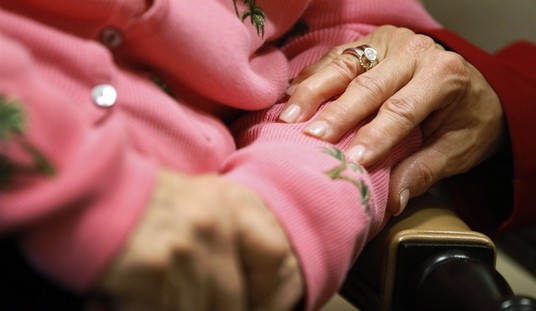Joe Biden was attempting to show how on the ball he is this week at a briefing on the nation’s wildfire situation. It didn’t work.
Biden was meeting with Western governors so he could be seen talking about the annual phenomenon of wildfires and how awful they are and how we must do everything to stop them, even though that just makes future ones worse.
“We know this is becoming a regular cycle,” the president said, “and we know it’s getting worse. The truth is, we’re playing catch-up. This is an area that’s been under-resourced, but that’s going to change if we have anything to do with it.”
There is so much so very ignorant about what Joe Biden said.
First, wildfire is not becoming a regular cycle. It already is. Has been forever since the beginning of fire and time. Fire is how Nature cleanses itself and launches the next cycle, all on a schedule that ignores humans.
Wildfires are getting worse, not because of global warming or climate change or whatever the green catchphrase is this summer. Wildfires are getting worse because humans insist on letting fuels build up, then fighting the fires, snuffing out flames before they can do their job. Oh, and humans are building houses closer to and even within woodlands.
As more people move from festering cities into wooded areas, building expensive homes that they expect taxpayer-funded fire departments to protect. Not unreasonable by itself.
Nature doesn’t stop growing and dying and accumulating volatile fuel just because most of us pay no attention until the flames are on TV. Every year, every acre of woodlands grows tons of potential fuel – fallen branches, brush, needles.
Douglas fir trees, for instance, look ever green((cq)) because they shed only 20 percent of their needles each fall. Like leaves only more flammable. The needles accumulate on the ground, year after year. Ever throw a fistful of dry needles onto a campfire? Whoosh! And little burning pieces rise on the hot air currents to spread the embers. That’s how Nature cleanses itself.
Here’s a News Flash for D.C. denizens: When things get primed to burn in Nature, they burn. Thousands of lightning bolts strike ground in the West every night. Government satellites mark where each hits.
If any of them strike a dry spot, usually in remote areas, a fire starts. That heat shows up, too, on satellite images.
On some days of low winds and somewhat higher humidity, firefighters at times can steer the flames away from buildings and/or toward lakes or rivers. But many times all anyone can do with a large wildfire like a hurricane is basically get the hell out of the way.
Bark beetles have killed millions of trees on thousands of Western acres, creating tons upon tons of drying wood awaiting ignition. For one year, maybe two, that dead wood could be harvested and put to use economically in a sector where lumber prices have soared over short supply.
After that, Nature starts its own recycling process. The wood gets cracked, infested with worms, and worthless for anything but a fire, in your fireplace or the wild.
Environmental lawsuits and federal regulations have crippled the logging industry, in effect, stalling most logging projects beyond the time the timber is worth logging.
Western governors know all this. Biden was telling them only to be seen on-camera sounding like he knows something. The governors all know that wet springs are good for growth. Wet springs create all the green growth that wild creatures eat and nest and hide babies in.
But that brush dries out when hot days creep in, as they do every summer around now. And that makes even more fuel for wildfires to consume.
In the days before settlers began flowing into the American West, native Americans started their own wildfires. They had no environmental regulations to obey. Their fires could burn for months. They knew if flames cleared out the brush and some trees, deer and other wildlife would soon move back in to ease hunting and life’s balance.
They also knew that the ash from the fires fertilized the hungry soil, creating immense areas of flourishing berries and other foods that fed them and attracted huntable creatures.
Wildfires in the American West are awe-inspiring monsters. Up close, they roar like dragons, sucking in air from behind, pre-heating and blowing it out in front to prep awaiting fuel. Sometimes the heat creates fiery mini-tornadoes the size of a silo.
These wildfires do not creep like a flame consuming a piece of paper from one edge to the other. Wildfires literally leap from tree to tree, even mountainside to mountainside. Watching from a distance, it looks like someone is suddenly lighting thousands of 100-foot-tall candles all over the mountainsides.
They’re not really catching on fire. With the pre-heating, they simply explode in yellow and red flames with a sudden whoosh tree by tree, moving faster and faster up the mountainsides as the hot air rises. No one can outrun that.
Each exploding tree sends flaming embers flying to spread the conflagration. Sometimes these explosions are so violent and the hot air currents so strong a huge flaming branch will soar up and over the ridge to ignite a new area.
To combat such events, states and the feds have helicopters dangling giant buckets they fill in nearby lakes. And there are waterbombers like combat planes. At just a few hundred feet, they must fly fast enough to plunge under control through a fire’s powerful updrafts, but slow enough to accurately target the hot spots with tons of fire retardant, which is orange to mark the path for following planes.
On some wildfires I worked in emergency state government, U-2 spy-craft flew over gathering thermal imaging to show fire managers where to dispatch crews.
Where they go, wildfires consume everything with temperatures that can melt cast iron. But the flames don’t go everywhere. As if by some magical plan, they hop around, leaving large irregular blocks of trees untouched, which provides wildlife refuge and a source of seeds, acclimated to the altitude and moisture, to repopulate burned areas next door.
The aftermath of these conflagrations is like an eerie battlefield, a monochrome world of black and ashen gray. Firefighters in bright yellow or orange traipse through the destruction with backpacks. Tree stumps where the flammable sap and pitch reside often become underground furnaces, glowing molten red inside and emitting mini-roars that crews flood before they ignite a new blaze.
But in the choreography of forest life, even as smoke hangs heavily in the air, new life has already begun. Tree species in Western forests come in cycles. First, the ones that need maximum sunlight emerge. Their pinecones may have been sitting on the forest floor for generations, awaiting the intense but passing heat of a fire to melt their sealant and release the seeds, which find vast nutrients in the ash.
Later, seeds of the species that need shade drift in on winds to await the right combination of moisture and light before springing up to compete and eventually shade out the pine pioneers.
It’s an amazing cycle that will take more than a century to creep through today’s smoldering former forest, far longer than any of these politicians will be around to prance through their photo-ops.
Joe Biden told the governors this week he had devised a bold strategy to fight wildfires. The first step he promised was to have an annual wildfire briefing with them just like this week. And because a Biden media event wouldn’t be one without more spending, he said he was raising federal firefighter pay from $13 to $15 an hour.
Then, the President of the United States revealed both his priorities and ignorance. “Wildfires,” Biden declared unequivocally, “are not a partisan phenomenon.”













Join the conversation as a VIP Member